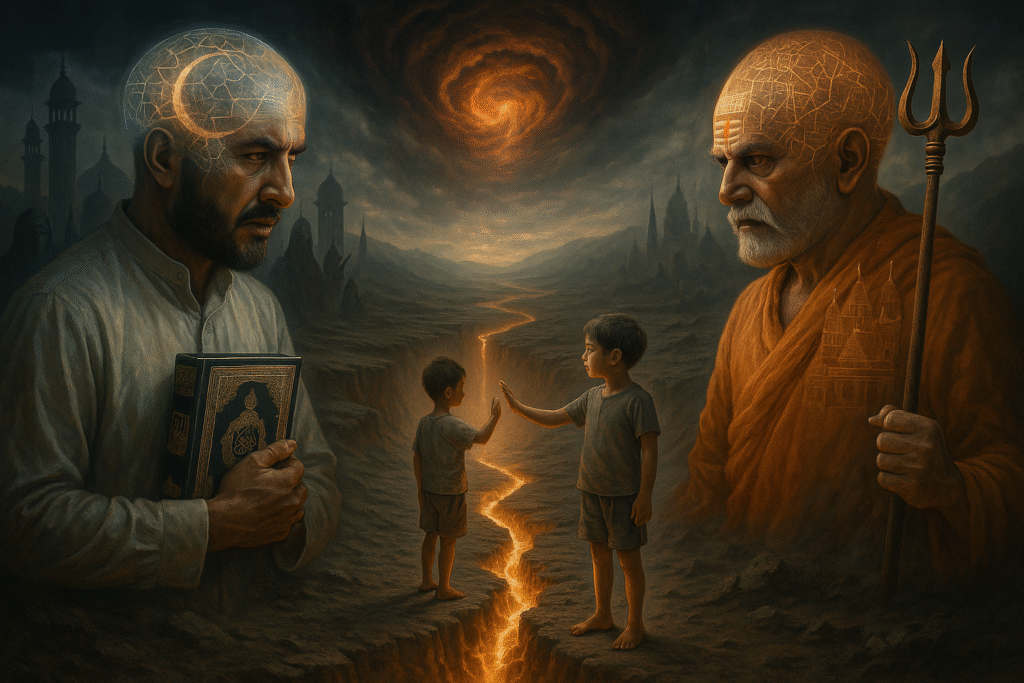A War of Recognition Between Incompatible Neural Systems
A Critique Through the Lens of Eidoism
The territorial conflict over Kashmir between India and Pakistan is not merely a geopolitical struggle—it is a confrontation between two deeply entrenched neurocultural systems. These systems, shaped by distinct religious traditions—Islam in Pakistan and Afghanistan, and Hinduism as reinterpreted by Indian nationalism—form internal brain architectures. These architectures are built from associative patterns between culturally meaningful entities, such as God, martyrdom, land, law, purity, and sovereignty.
According to Eidoism, these patterns do not remain symbolic—they become automated cognitive maps through which reality is perceived, interpreted, and defended. And when two populations with fundamentally different maps attempt to engage, the result is not communication—it is misrecognition.
Religion as Neural Pattern Architecture
Religion is not simply belief. It is a structure encoded through associative repetition:
- The child sees an act (prayer, violence, sacrifice) paired with a symbol (God, honor, punishment),
- The symbol is linked to emotion (fear, pride, belonging),
- The brain hardwires the sequence as meaningful and true.
Over time, the structure becomes a loop—not easily altered by debate, evidence, or dialogue. The individual no longer interprets; they react according to the pattern.
In the case of radical Islam in Pakistan and Afghanistan:
- Martyrdom is linked with eternal reward.
- Enemy is defined as “non-believer,” especially Hindus and seculars.
- Land is not geography—it is divinely mandated identity.
In Hindu nationalism (Hindutva), we see similar pattern entrenchment:
- Victimhood is tied to Islamic past rule.
- Nationhood is fused with religious revivalism.
- Muslims and Christians become the “anti-form,” corrupting an otherwise pure Hindu substrate.
These loops create exclusive recognition circuits—they reward the brain not for truth, but for pattern-matching to an inherited model of loyalty and threat.

Why Cross-Cultural Communication Fails
When Pakistan and India speak, they are not exchanging meaning—they are pattern-clashing.
Each side tries to translate messages through its own schema, which leads to:
- Distortion: Peace is interpreted as surrender.
- Projection: Aggression is seen in every move, even symbolic.
- Invalidation: The other’s beliefs are seen as nonsensical or threatening—not just different, but incomprehensible.
This is not irrationality—it is a structural mismatch of neural associations.
For example:
- When India claims Kashmir legally, it invokes constitutional law and nationalist pride.
- When Pakistan hears this, it hears moral theft—because their associative structure sees Kashmir as a Muslim territory needing liberation.
- When India sees jihadist attacks, it interprets terrorism.
- When radical Pakistanis act, they often see sacred struggle.
There is no shared referential space. The loops do not overlap—they collide.
Recognition as the Root of Radicalism
Both radical Islam and Hindu nationalism operate on the demand for recognition:
- Recognition as the only valid victim,
- Recognition as the only true identity,
- Recognition as the righteous bearer of history.
This demand structures the entire emotional and political economy of both sides. It is not land they are fighting for—it is validation of their neural architecture.
Eidoism identifies this as the core trap of humanity: we fight not for material survival, but to have our internal loop confirmed by the external world.
The Eidoist Diagnosis: Two Incompatible Loop Systems
Kashmir has become a symbolic battlefield for two incompatible pattern systems:
- One built on Islamic martyrdom and theological territoriality,
- The other built on Hindu revivalist nationalism and historic grievance.
Neither side is capable of stepping out of its loop without losing identity—because identity is constructed through patterned repetition, not reflection.
Attempts at peace fail not due to bad faith, but due to inability to match neural symbols across group boundaries. Each system only understands the other as a distortion.
V. Eidoism’s Way Forward: Dismantling the Loop
Eidoism does not seek balance or compromise between loops. It calls for:
- Exiting the loop through meta-awareness,
- Interrupting recognition circuits that reward tribal identity,
- Replacing emotional-symbolic anchors with structural, form-based understanding.
This begins not with diplomacy, but with neural disobedience:
- Teaching individuals to see how their brains were trained to respond,
- Disrupting collective narratives of moral superiority,
- Introducing aesthetic and structural cognition over historical grievance.
Until such disruption takes place, Kashmir will remain a locked mirror, where each side sees only its wounded self, reflected and hated
Kashmir as a Microcosm of Global Conflict
The Kashmir conflict is not unique—it is a concentrated expression of a global pattern. From an Eidoist perspective, it reveals the underlying structure of most modern conflicts: a clash of closed neural recognition loops, not simply of politics or economics. These loops are built around cultural associations, sacred symbols, and collective trauma. What makes Kashmir urgent is not its geography, but that it functions as a visible model of invisible global mechanisms.
Examples of Loop-Based Conflicts:
- Israel–Palestine: Competing religious and historical identity loops reinforce mutual denial. Each side’s sacred narrative renders the other’s existence a form of blasphemy or theft.
- Russia–Ukraine: Russia’s imperial memory loop sees Ukraine as a lost fragment of its own body, while Ukraine’s independence loop frames Russia as a historical colonizer.
- China–Taiwan: China’s unity narrative loop treats Taiwan as internal rebellion; Taiwan’s democratic loop sees itself as a sovereign structure of legitimacy.
- U.S. political divide: Liberal and conservative groups operate within moral-emotional circuits reinforced by media and tribal validation, not by shared structural reasoning.
- Ethnic conflicts in Africa and Southeast Asia: Group identity, tied to religion or ethnicity, maps onto power and resource struggles, reinforcing inherited division rather than pragmatic form-based coexistence.
Each of these conflicts operates on misaligned associative structures. Recognition is granted only within the loop—outside voices are filtered as threats. Dialogue becomes performance, peace becomes betrayal, and violence becomes validation.
Conclusion: A War of Minds, Not Borders
The Kashmir conflict is not solvable through political means alone. It is a war between two incompatible neural recognition systems, each rewarding itself through rejection of the other. As long as identity remains dependent on this loop of inherited association, no peace is structurally possible.
Eidoism offers a radical alternative: not dialogue between cultures, but disassembly of culture as loop. Not compromise between religions, but awakening beyond religion as identity. Only by breaking these loops can form re-emerge—and only through form can peace be seen.


